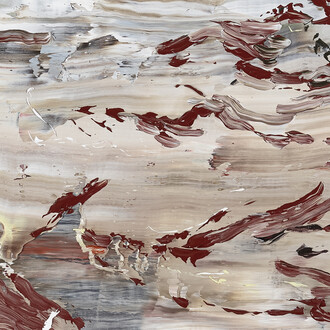Galleria Continua is delighted to welcome Shilpa Gupta back to its San Gimignano space. Widely regarded as one of the most significant international artists of her generation, Gupta presents an exhibition featuring a compelling and varied selection of works, each rooted in her ongoing critical engagement with themes of mobility, control, and acts of resilience. Among them is a newly created installation for the auditorium of the former cinema theater.
The exhibition opens with a large embroidered piece that meditates on the limitations of state-sanctioned borders. Using a delicate, fine thread, Gupta reimagines symbols of national identity through densely layered forms inspired by flags, subtly questioning the state’s role in imposing order and uniformity within societies shaped by the fluidity of cultures and the mutability of belonging.
This exploration of borders and liminal thresholds continues in Untitled (2020), a river stone collected from a border region and a lightbulb engage in a delicate dance, almost like a conversation. As one rises, the other lowers; when they meet, the light briefly illuminates the stone’s shimmering gray surface. Though they come close, they never quite touch—their exchange remains precarious and fragile, underscored by the ever-present risk of destruction if the stone were to collide with the delicate bulb.
Gupta’s interest in lines, drawn or enforced, are revisted Untitled (2023) explores how authority seeks to limit mobility of bodies and voices. The kinetic installation is part of a series in which Gupta uses inverted wired microphones to reflect on censorship and silenced truths, prompting us to consider how political structures can evolve into systems of control and repression. A lone voice recites the names of 100 poets from different geographies and eras, along with the years they were detained or imprisoned by their respective states. “Poets, like writers and artists, are dreamers who speak of the world’s nightmares. This work is about the persistence of beliefs and dreams—the things that make us who we are as individuals,” says Gupta.
A fragmented, poetic stream of evocative phrases in constant motion—this is the essence of Sound on my skin (2010–2025). The work features a classic mechanical split-flap display, once a familiar fixture in airports and train stations, used to announce arrivals and departures. Here, its flipping panels instead generate a continuously shifting sequence of words, forming a poetic text that is both layered in meaning and in a perpetual state of transformation.
“Sometimes by chance, sometimes deliberately, after looking at the same construct from a different perspective, a new narrative emerged,” says the artist. She continues, “It might be slightly different or even quite contradictory, forcing me to reconsider and rework what I thought I knew and how I knew it. This process can be frustrating, rewarding, and sometimes even unsettling. Perhaps that’s why I am drawn to relationships that feel almost distant—where focal points shift, and you move together with the audience, turning and rotating in unison.”
Truth (2022–2025), the large-scale walkable installation that Gupta inhabits in the auditorium, invites the audience to rethink their perception of space and time, experience shifting viewpoints, and reconsider the relationship of power over narratives.












